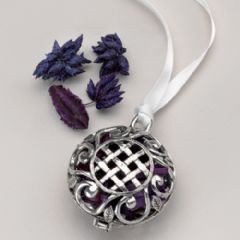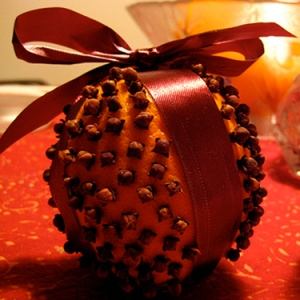 Throughout history, the importance of scent has never been denied. Mystical and powerful, scent was an offering, a force of attraction and a curse. The pomander, a ball filled with perfumes worn from the Middle Ages onward, was a form of protection against sickness and death.
Throughout history, the importance of scent has never been denied. Mystical and powerful, scent was an offering, a force of attraction and a curse. The pomander, a ball filled with perfumes worn from the Middle Ages onward, was a form of protection against sickness and death.
Origin
The word “pomander” originates from the French “pomme d’ambre.” A common interpretation of this phrase is “apple of ambergris,” referring to the wax substance used as a base in pomander recipes. Others take the phrase to mean “apple of amber” or “golden apple,” as in the fragrant citrus fruits exchanged during holidays for good luck.
Purpose
The pomander became popular during the Middle Ages when the black death and other ailments ran rampant. Sanitation during the era was lamentably lacking. The streets and even some homes were strewn with filth, bodily fluids and the discarded remnants of past meals. People thought that the cause of their problems lay in the resulting stench lingering about the city. The belief went that the pleasant scent of a pomander could repel the disease in the air.
Recipe
Several recipes for pomanders survive from the era. To the base of ambergris, musk, civet, rose water, and other perfumes and spices were added. The mix would then be inserted into the pomander’s container. A pomander could be worn around the neck or waist. Many women attached them to their girdles.
Both men and women wore pomanders, most of whom hailed from the elite classes of society. Queen Elizabeth I is frequently depicted wearing one, as are other nobles and notables of the day. People took great pride in their pomanders. Simple pomanders were made of wood, while the most stunning examples were worked in silver or gold, studded with precious stones, and etched with intricate designs. Some pomanders were divided into sections, similar to an orange, into which its wearer would place several different scents.
Evolution
As time wore on, the pomander began to take on the “golden apple” interpretation. By the 18th century, a pomander was more often than not an orange studded with cloves and other spices. These made for popular gifts during Christmas and New Years. Many people make this type of pomander today in order to scent their homes and clothing.

[…] my children were small I have been buying thin-skinned oranges and a big jar of cloves to make pomanders. We would sit around the table with a bowl of cloves and a pile of oranges spearing the cloves […]
I use to do that with my mom when I was younger. Im thinking of starting the tradition with my daughter this Christmas or next year. Its just such a wonderful smell.
Reblogged this on Valentina Expressions and commented:
A very interesting and amusing reading. Thanks for sharing.